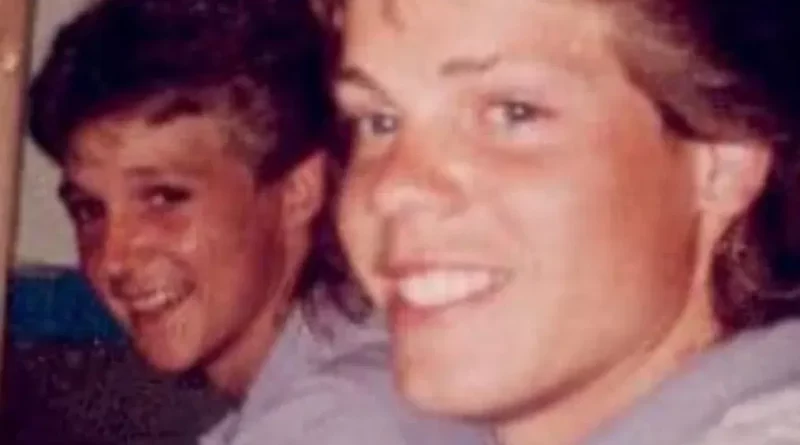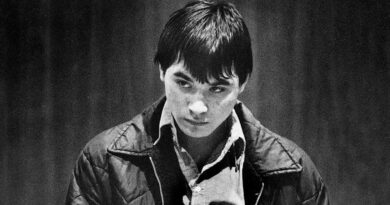The Death of The Boys on the Tracks Don Henry and Kevin Ives in Alexander Arkansas
On the night of August 23, 1987, the small town of Alexander, Arkansas, became the epicenter of one of the most perplexing and controversial cases in U.S. history. Two teenage boys, 16-year-old Don Henry and 17-year-old Kevin Ives, were tragically killed after being struck by a Union Pacific freight train. Initially deemed an accident, subsequent investigations uncovered troubling evidence of foul play, suggesting their deaths were far from accidental. Known as the case of the “Boys on the Tracks,” the mystery surrounding their deaths has captivated investigators, journalists, and conspiracy theorists alike.
The Night of the Tragedy
In the early hours of August 23, the crew of a 75-car freight train traveling to Little Rock spotted two figures lying motionless across the tracks. The engineer immediately applied the emergency brakes and sounded the horn, but stopping the 6,000-ton train in time was impossible. Tragically, the train rolled over the bodies, severing and mutilating them.
The crew reported that the boys were partially covered by a green tarpaulin. Police would later dispute the existence of the tarp, adding to the confusion and mistrust surrounding the investigation. Beside the bodies lay a .22 caliber rifle and a flashlight, leading authorities to believe that the boys had been out hunting—a plausible theory given their rural location and the popularity of spotlighting, a nighttime hunting method.
Law enforcement arrived by 4:40 a.m. and began processing the scene. Initially, the deaths were considered a bizarre accident: two boys, incapacitated by drugs, had fallen asleep on the tracks. But as more evidence came to light, it became clear this was no ordinary case.
The Initial Autopsy and Its Fallout
The state medical examiner, Dr. Fahmy Malak, quickly concluded that the boys had died as a result of accidental causes. His report stated that both boys were incapacitated by extreme levels of THC, the psychoactive component in marijuana, having smoked the equivalent of 20 marijuana cigarettes. According to Malak, this caused them to fall into a deep sleep on the tracks, oblivious to the approaching train.
The boys’ families were immediately skeptical of this finding. Friends and relatives described Kevin and Don as responsible teens unlikely to endanger themselves. Additionally, experts and pathologists questioned Malak’s conclusions. The idea of anyone smoking such an extreme amount of marijuana and simply passing out in such a manner was medically implausible.
Facing mounting pressure, the families demanded a second autopsy, which was conducted by Dr. Joseph Burton, a forensic pathologist from Georgia. Burton’s findings cast serious doubt on Malak’s conclusions. He determined that the boys had only consumed a small amount of marijuana—equivalent to one or two joints—far below the level needed to cause unconsciousness. More disturbingly, he discovered injuries indicating homicide. Don Henry had a stab wound in his back, while Kevin Ives had suffered a skull fracture, possibly inflicted by his own rifle.
These findings prompted a grand jury to overturn the original ruling, declaring the deaths “probable homicides.” Subsequent evidence would change this to “definite homicides.”
Evidence of Foul Play
Beyond the autopsy findings, other troubling details began to emerge:
- The Green Tarpaulin: While train crew members insisted they had seen a tarp covering the bodies, law enforcement denied its existence, and no tarp was ever recovered from the scene. This discrepancy has led to accusations of evidence tampering or negligence.
- The Boys’ Injuries: The second autopsy revealed trauma inconsistent with an accidental death. Don Henry’s stab wound and Kevin Ives’ skull injury suggested they had been attacked before being placed on the tracks.
- The Rifles and Gravel: Don Henry’s father, Curtis Henry, argued that his son, a careful and protective hunter, would never lay his gun on the gravel where it could be scratched—further evidence that the boys were moved after their injuries.
These facts pointed to foul play, but the local investigation remained fraught with missteps and controversy.
A Flawed Investigation
From the start, the investigation into Don Henry and Kevin Ives’ deaths was plagued by problems. Saline County Sheriff James Steed Jr. was criticized for his refusal to investigate, citing insufficient evidence. Under pressure from the families, Steed reluctantly reopened the case but faced accusations of incompetence and obstruction. Key evidence, including the boys’ clothing, was mishandled; instead of being sent to the FBI for analysis, it was sent to the Arkansas State Crime Lab, which lacked the resources for thorough examination.
Meanwhile, witnesses connected to the case began dying under mysterious circumstances. At least five people who were either set to testify or possessed knowledge about the boys’ deaths were killed or disappeared between 1988 and 1990. The deaths of these individuals, classified as murders, further complicated the investigation and fueled suspicions of a larger conspiracy.
Theories and Speculations Surrounding the Boys on the Tracks
The deaths of Don Henry and Kevin Ives on August 23, 1987, continue to baffle investigators, journalists, and the public. Initially ruled as an accident caused by marijuana intoxication, the case took a sharp turn when evidence pointed to homicide. Over the years, numerous theories and speculations have emerged to explain what might have happened to the two teenagers. These theories range from plausible accounts of local criminal activity to elaborate claims of government cover-ups, with most centered around one unifying factor: drugs.
The Drug Trafficking Connection
One of the most widely accepted theories is that Don Henry and Kevin Ives stumbled upon a drug operation and were killed to silence them. During the 1980s, Arkansas, particularly the Mena Airport in nearby Polk County, was reportedly a hotspot for drug smuggling. This operation was allegedly linked to Barry Seal, a pilot working for the Medellín Cartel, and involved transporting drugs into the United States.
Witnessing a Drug Drop
Supporters of this theory believe the boys were in the wrong place at the wrong time, possibly seeing a drug drop from a low-flying airplane. It is speculated that the individuals involved in the operation panicked and killed the boys to prevent them from talking. This theory gained credibility due to the presence of the Mena drug smuggling ring, which had documented ties to Arkansas in the 1980s.
Corruption and Cover-Up
This theory implicates local law enforcement, prosecutors, and possibly state-level officials in a coordinated cover-up. Allegedly, individuals in power were either complicit in or directly involved with drug trafficking operations. Critics point to the mismanagement of evidence and the deaths of key witnesses as signs of deliberate sabotage.
The drug connection theory was further popularized by The Boys on the Tracks, a book by investigative journalist Mara Leveritt, and the documentary Obstruction of Justice: The Mena Connection. These works argue that the murders were part of a larger network of criminal activity that extended far beyond Arkansas.
Political Allegations and the “Clinton Connection”
Another prominent theory ties the case to then-Governor Bill Clinton. Conspiracy theorists claim that Clinton, who governed Arkansas at the time, was aware of the drug trafficking at Mena Airport and may have been complicit in shielding those involved. This theory gained traction in the 1990s with the release of The Clinton Chronicles, a controversial film that accused the Clintons of engaging in corruption and covering up the murders of Don Henry and Kevin Ives.
While these claims are widely regarded as unsubstantiated and politically motivated, they have remained a focal point for those who believe the case involves a larger conspiracy. It’s important to note that no concrete evidence has ever tied Bill Clinton or his administration to the case or the drug trafficking operations at Mena.
Rogue Law Enforcement Theory
Some speculate that members of local law enforcement were directly involved in the boys’ deaths. This theory emerged after the release of Obstruction of Justice, which alleged that two local police officers were responsible for murdering Don Henry and Kevin Ives. The documentary claimed these officers were involved in protecting drug operations and silencing anyone who posed a threat.
Dan Harmon’s Role
Dan Harmon, the prosecutor who initially represented the families of Don Henry and Kevin Ives, later became a suspect in the eyes of some theorists. Harmon was arrested in 1997 on charges of racketeering, drug possession, and extortion. His conviction added fuel to the belief that local officials were part of a corrupt network tied to the boys’ deaths.
Witness Elimination
Another chilling theory involves the deaths of multiple witnesses connected to the case. Between 1988 and 1990, at least five individuals with knowledge of the crime either died or disappeared under suspicious circumstances:
- Keith McKaskle: An informant who had taken aerial photos of the crime scene, McKaskle was stabbed to death just days after warning others that he feared for his life.
- Greg Collins: A witness subpoenaed to testify before a grand jury, Collins was shot multiple times with a shotgun.
- Keith Coney: Another witness and friend of Collins, Coney died in a motorcycle crash after allegedly being pursued.
- Daniel Bearden: Bearden disappeared without a trace in 1989.
- Jeffrey Edward: Linked to the case, Edward’s body was found in a landfill in 1989.
The deaths of these witnesses suggest a pattern of silencing those who might expose the truth. Supporters of this theory argue that the murders were deliberate acts to protect the perpetrators and their criminal activities.
The Botched Accident Theory
Some theorists suggest that the deaths were the result of a botched accident that escalated into a murder cover-up. This theory posits that someone in the area, perhaps involved in illegal hunting or a minor drug operation, accidentally injured one or both boys. Fearing repercussions, they staged the scene on the tracks to make the deaths appear accidental.
While this theory lacks the dramatic appeal of drug conspiracies or government cover-ups, it has been proposed as a more plausible explanation for the events of that night. However, it fails to account for the larger pattern of witness deaths and investigative missteps.
The Green Tarpaulin Mystery
One of the most debated aspects of the case is the report of a green tarpaulin covering the boys’ bodies. Train crew members claimed to have seen it, but law enforcement denied its existence, and no tarp was ever recovered. If a tarp was indeed present, it could indicate that the bodies were deliberately placed on the tracks after their deaths—a detail that further supports the murder theories.
Some theorists argue that the tarp was removed as part of a cover-up, while others believe the crew might have mistaken shadows or debris for a tarpaulin. Regardless, the dispute over this detail has fueled ongoing speculation.
Organized Crime and Local Politics
Other theories link the case to organized crime, suggesting that the boys’ deaths were tied to local drug syndicates operating with the tacit approval of corrupt officials. These theories often point to the chaotic state of Arkansas law enforcement during the 1980s, where criminal activities were frequently overlooked or mishandled due to lack of oversight.
The Fight for Justice
For decades, the families of Don Henry and Kevin Ives—particularly Kevin’s mother, Linda Ives—fought tirelessly for justice. Linda spearheaded her own investigations, confronted authorities, and pushed for transparency in the case. Her efforts brought national attention to the boys’ deaths and highlighted systemic failures in law enforcement.
Linda Ives’ advocacy included legal battles to unseal records and publicize evidence, as well as participation in documentaries that brought the case to a wider audience. Despite her relentless pursuit of the truth, Linda passed away in 2021 without seeing the case resolved.
The Enduring Mystery
More than 35 years later, the deaths of Don Henry and Kevin Ives remain shrouded in mystery. The case has been profiled in books, television shows like Unsolved Mysteries, and countless online forums, but no arrests have been made, and the truth remains elusive.
The case serves as a stark reminder of the importance of accountability and transparency in criminal investigations. For many, it also symbolizes the resilience of families in the face of institutional indifference and corruption. While the “Boys on the Tracks” case may never be fully solved, it continues to inspire calls for reform and justice in unsolved murders nationwide.
Discover more from City Towner
Subscribe to get the latest posts sent to your email.




